Abstract
Background:
Halitosis or breath odor, is defined as an unpleasant or offensive odor emanating from the mouth. Three forms are distinguished: genuine halitosis, pseudohalitosis and halitophobia. The source of 85% of all cases of halitosis lies in the oral cavity. According to the literature, between 10% and 50% of the population suffers from halitosis. The objective of this study was to provide an assessment of halitosis using an organoleptic method, Oral Chroma™ Data Manager and patients’ subjective assessments of their condition.
Materials and Methods:
A total of 30 adult patients took part in the study. The patients were examined by a trained and licensed dentist. An organoleptic assessment was made of a patient’s breath (scale 0-5) and a test performed on air samples from the oral cavity using the Oral Chroma™ Data Manager. The organoleptic score was rated according to the Rosenberg Scale. Next, the patient had to fill out a Halitosis Associated Life-quality Test (HALT) questionnaire. A statistical analysis was performed using a Microsoft Excel spreadsheet and SPSS 17.0 statistical software. P < 0.05 was considered as significant.
Results:
According to the Tau b Kendall test, the correlation coefficient between the organoleptic assessment and the patient’s own assessment was 8.1%, while the rho Spearman correlation coefficient was 10.4%. In the majority of cases, the patient’s own assessment was higher than the organoleptic assessment. The HALT questionnaire revealed a Cronbach’s coefficient alpha was of 0.929.
Conclusions:
Halitosis requires not only professional care provided by dental specialists, but also psychological support.
Keywords: Breath tests, halitosis
Introduction
Halitosis or breath odor is defined as an unpleasant or offensive odor emanating from the mouth. Halitosis is regarded as genuine when symptoms are objectively present (subclassified into physiologic and pathologic), while two other forms distinguished are pseudohalitosis and halitophobia. Physiological halitosis is also called “morning bad breath” and occurs mostly due to a decrease in saliva secretion during the night. Pathologic halitosis is subdivided into intraoral and extraoral halitosis. Eighty-five per cent of all cases of halitosis has their source in the oral cavity. These are usually the following: pathologically coated tongue, periodontal disease, carious teeth, etc. Other causes of halitosis are liver, kidney, lung and ENT diseases as well as metabolic disorders (diabetes mellitus, trimethylaminuria).
The chemical compounds responsible for the bad odors originating from the oral cavity are volatile sulfur compounds (VSC) (e.g. hydrogen sulfide, methyl mercaptan), nitrogen, indoles, scatoles, organic acids (e.g. butyric acid) and others. According to the literature, between 10% and 50% of the population suffers from halitosis.1-5
The bad breath paradox consists in the fact that a person suffering from halitosis is often not aware of it, while another may be convinced that his/her breath smells bad, when in fact, the symptoms of halitosis are absent. A person’s inability to sense his/her own unpleasant breath may result from the fact that exhaled the air is diluted so that during inhalation the unpleasant odor can no longer be sensed. However, a number of methods can be used (such as licking one’s own wrist and sniffing it, sniffing saliva samples collected in a cup, exhaling air into paper bag and smelling samples) to assess one’s breath more objectively. Studies have shown, however that these methods rarely correlate with tests performed by qualified investigators (“odor judges”).
If objective symptoms of halitosis are not present, and the patient still complains of having oral malodor, it could be because of disorders of the nervous system or a result of pseudohalitosis and halitophobia. The latter two disorders may have a mental illness substrate. Pseudohalitosis can be treated by dental practitioners, but halitophobic patients must be referred to psychological specialists.
Oral malodor can be measured using organoleptic measurements or gas chromatography analysis.6,7 An organoleptic score is based on the Rosenberg Scale of 0-5, where 0 = absence of odor, 1 = barely noticeable odor, 2 = slight malodor, 3 = moderate malodor, 4 = strong malodor, and 5 = severe malodour.8
The HALT questionnaire, a specific 20-item, quality- of-life measurement of halitosis, is, as the author says, a de novo designed tool based on patient interviews and a literature review.5 It is an instrument that provides a comprehensive assessment of the physical, social and psychological negative impact of oral malodour.9 According to Kizhner et al.,5 HALT was devised with a Likert scale of 0-5; a higher score indicated a worsening of that single measure. HALT comprises 20 items and has a maximum score of 100. With a cumulative score lying within a range of 0-100, a higher score would indicate a greater impact on an individual’s quality of life. In addition, treatment or monitoring is assessed according to the difference between an initial score and any that follow.5
Objective
The objective of this study was to assess halitosis using the organoleptic method based on the Oral Chroma™ Data Manager and the patient’s own subjective assessment of his/her condition.
Materials and Methods
The study was approved by the Bioethics Committee of the Jagiellonian University in Krakow, Poland (KBET/134/B/2013). The patients were informed both verbal and in writing about the purpose and methods of the study. All signed forms are giving their informed consent.
A total of 30 adult patients (aged above 18) of both sexes (female = 16, male = 14) took part in the study. All the individuals enrolled in the study reported a primary complaint of oral malodor. The patients were examined by a trained and licensed dentist.
Clinical examinations of the subjects were always performed between 7.30 and 10.00 in the morning. Prior to the examination, the patients were given a list of instructions: they were prohibited from consuming garlic, onion, spicy food and alcohol beverages one day before the examination. On the morning of the appointment when the participants were to be assessed for oral malodor, they were instructed to refrain from using scented personal products, eating breakfast and from brushing their teeth.
Subsequently, an organoleptic assessment was made of the patients’ breath (scale 0-5) while air samples from the oral cavity were tested using the Oral Chroma™ Data Manager.
The organoleptic score was rated according to the Rosenberg Scale.8
Patients were diagnosed with halitosis if they noted the following parameters: Level of ≥125 ppb of VSC and organoleptic assessment ≥2.
The next stage of the study involved filling out a Halitosis Associated Life-quality Test (HALT) questionnaire – devised by Kizhner et al.5 for patients with halitosis while the patients themselves gave a subjective evaluation of the intensity of their mouth odor on a scale of 0-5. The patients also answered questions regarding demographics (gender and age).
Statistical analysis
Statistical analyses were performed using a Microsoft Excel spreadsheet and SPSS 17.0 statistical software.
Descriptive characteristics of the study group show the minimum, maximum, mean and standard deviation, as well as the median and interquartile stretch marks (25 and 75 percentile). In addition, the coefficient of variation was calculated to assess the diversity of the population. Discrepancies between the sensory evaluation and self-assessment by the patient were assessed on the basis of the Spearman correlation coefficient and Kendall’s Tau b coefficient (due to a distribution that deviated significantly from the norm). The normal distribution was evaluated on the basis of the results of the Shapiro-Wilk test. For the results of the survey, the average, standard deviation and median for the descriptive characteristics of the study group were shown. In order to verify the reliability of the scale the Cronbach’s coefficient alpha was calculated and split-half reliability analysis was performed. P < 0.05 was considered as significant.
Results
Grade 3 oral bad breath (on a scale 0-5) was noted in 30% of the patients participating in the study. A grade 2.5 unpleasant odor was observed in the mouths of 26.7% of the patients. In another 50% of the patients, bad breath was graded at less than or equal to a coefficient of 2.5. The most extreme conditions were only observed in a minimum number of patients.
Twenty-one patients had a VSC of ≥12 5ppb. At the same time, 26 patients suffered from oral bad breath with a grade of ≥2.
Cronbach’s alpha for the test in our study was 0.929, while in Kizhner’s study Cronbach’s alpha was 0.93 (Table 1).5
Table 1.
The descriptive characteristics of the study group.

In the case of the “organoleptic assessment” 50% of the patients graded their breath as unpleasant with a grade of less than or equal to Grade 2. In 50% of the patients (median observations) the organoleptic assessment was in the range of 1-2.5.
The average “patient’s self-assessment” variable was 2.68 and the standard deviation 0.951.
In the case of the “VSC SUM” variable 50% of patients had a result less than or equal to 525. For 50% of the patients (median observations) the variable was within the range of 39-782.5 (Table 2).
Table 2.
Subjective assessment versus organoleptic assessment.
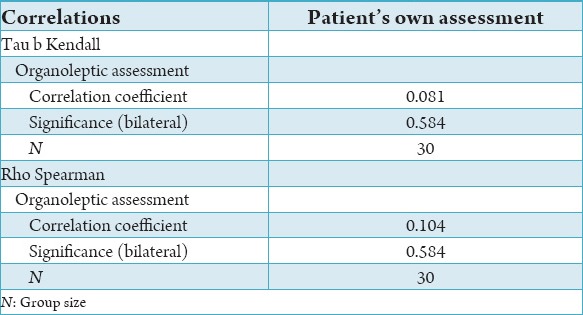
The correlation between the organoleptic assessment and the patient’s own assessment was statistically not significant, according to both the Tau-b Kendall test and the rho Spearman test (P > 0.05). This results from the fact that the correlation allows for low values. This means that no strong agreement existed between the organoleptic assessment and the patient’s own self-assessment. According to the Tau b Kendall test, the correlation between the organoleptic assessment and the patient’s self-assessment was 8.1%, while the corresponding indicator for the rho Spearman test was 10.4%.
The Wilcoxon Signed Ranks test was used to verify whether a patient’s evaluation differed substantially from the objective evaluation. The Wilcoxon Signed Ranks test is statistically significant (P < 0.05), and thus the results obtained can be subjected to further interpretation.
Differences between the patients’ own subjective assessments and the organoleptic assessments were interpreted on the basis of the table below (Table 3).
Table 3.
Frequency.

Patient’s own assessment < Organoleptic assessment – occurred in 3 cases,
Patient’s own assessment > Organoleptic assessment – occurred in 20 cases,
Patient’s own assessment = Organoleptic assessment – occurred in 7 cases.
In the majority of cases, the patient’s own assessment was higher than the organoleptic assessment.
Assessment of the scale reliability for the HALT test
The reliability of the scale is understood as its internal consistency which tells us how much individual items measure in relation to the scale as a whole. The alpha coefficient allows us to verify a proposed set of statements as indicators of analyzed issues.
The analysis revealed a Cronbach coefficient alpha of 0.929.
The average value and standard deviation were determined for each item. This data is presented in Table 4.
Table 4.
Questionnaire item statistics.
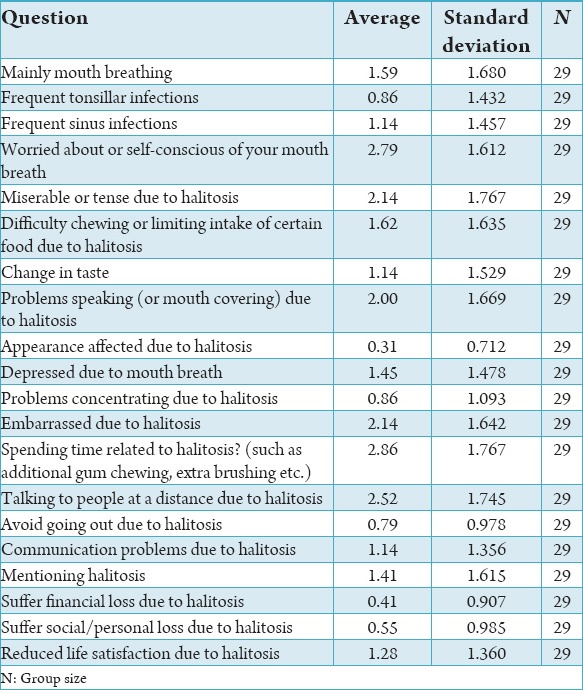
An assessment was then made of the properties of particular items. This collation is presented in Table 5.
Table 5.
Assessment of the properties of particular items in questionnaire.
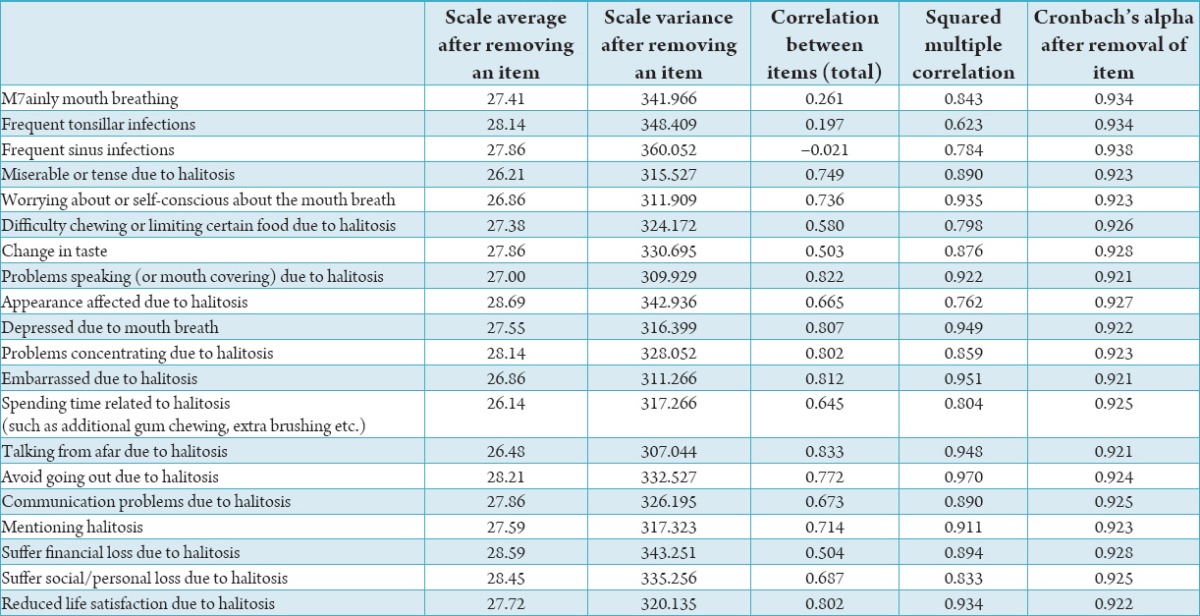
To help assess the suitability of specific items on the scale the following were applied:
Cronbach’s coefficient alpha, calculated after removing a specific item scale,
The standard deviation of the calculated scale, the defined item after removal of the scale,
The average value calculated after removing the scale specified item.
Cronbach’s alpha for the model as a whole was 0.929. It is reasonable to eliminate the item, which will increase the Cronbach’s coefficient alpha. The “Cronbach’s alpha” column, following the removal of a “specific item scale” did not indicate that the removal of any questions significantly improved the reliability of the survey.
The analysis also provided statistics for the scale as a whole. The average and variance for the entire scale did not deviate significantly from the statistics for individual items.
The significance of the entire solution was assessed using the Friedman Chi-squared test, for ordered scaling was used to assess each statement. The test results are presented in Table 6.
Table 6.
ANOVA with Friedman test.
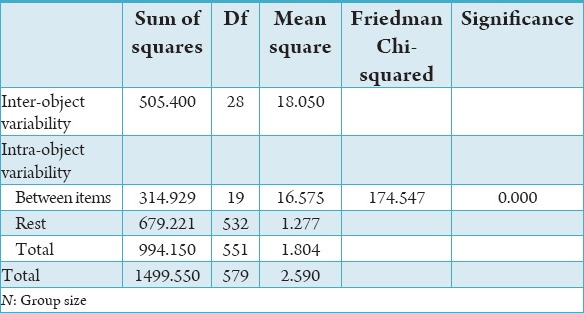
The test statistics adopted a value of 174.547 and statistical significance was set at below 0.000, which allowed a result to be regarded as statistically significant.
The Wilcoxon Signed Ranks test was used to determine whether when a patient has a high result in a questionnaire he also has a high organoleptic assessment and self-assessment.
The Wilcoxon Signed Ranks test was statistically significant (P < 0.05). Hence, the results could be subjected to further interpretation.
Differences between the patients’ subjective assessments and the questionnaire result as well as between the organoleptic assessment and the questionnaire result will be based on the table below (Table 7).
Table 7.
Frequency.
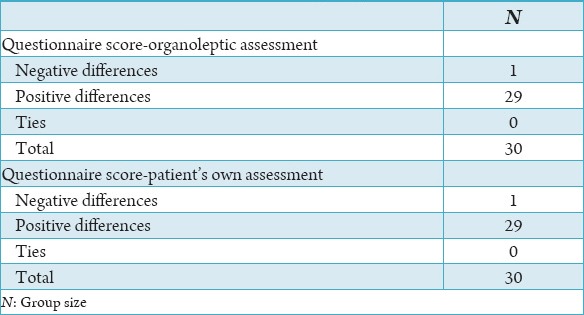
Questionnaire score < organoleptic assessment – occurred in 1 case,
Questionnaire score < patient’s own assessment – occurred in 1 case,
Questionnaire score > organoleptic assessment – occurred in 29 cases,
Questionnaire score > patient’s own assessment – occurred in 29 patients,
Questionnaire score = organoleptic assessment – did not occur,
Questionnaire score = patient’s own assessment – did not occur.
Discussion
Genuine halitosis and pseudohalitosis affect the quality of a persons’ life. Research confirms that our self-image is affected by what we perceive and by our interpretation of other people’s perceptions of us. Our breath odor is part of our self- and body-image. When a person has a negative image of his/herself, he/she avoids contacts with others, limits their social relations. Such a situation can affect his or her personal, professional and social life.10
Many devices exist which can detect the volatile compounds that cause malodor. According to McKeown, the organoleptic test is still the gold standard, even if instrumental methods have been introduced. This is because a machine can only detect VSC, while an odor judge can recognize and name complex mixtures of substances.10
There are numerous reasons why the percentage of halitophobic patients is so high. According to Iwanicka-Grzegorek et al. and Quirynen et al, it varies depending on the country, from 20% to as high as 50%.7,11 Quirynen et al. claim that two-thirds of these patients are women and add that they are least likely to believe that their malodor is subjective and does not actually exist. Among the factors that cause, halitophobia and pseudohalitosis are people’s growing self-consciousness and an increasing number of advertisements for oral hygiene products.11
The level of self-reported halitosis often does not correspond to the objective presence of halitosis. This is because it is difficult for individuals to assess their own breath.3 At the same time, Romano et al. claim that a person’s subjective assessment of bad breath correlates well with the presence of oral malodor determined by organoleptic examination. They found that patients with slight or moderate halitosis exhibited the strongest correlation between self- and odor judge assessments.6
Filippi and Müller conducted a study in which Filippi’s patients were asked about the state of their breath. All the patients were convinced that they suffered from halitosis. A specially developed questionnaire was followed by a dental examination and a diagnosis. A total of 141 patients answered the question “How intense is your bad breath?”. 56.5% of the patients with genuine halitosis (n = 124), and up to 76.5% of patients with mentally-related halitosis (n = 17) claimed that their bad breath was “strong”. There were no significant differences between the groups (P = 0.181). The risk estimate, however, showed that the relative risk of believing that one’s own bad breath was strong was 2.5 times higher in patients with mentally-related halitosis than in patients with genuine halitosis.12
Devising a questionnaire to measure the quality of life in patients with halitosis would appear important. As far as we know, no such questionnaires have been used in Poland before. Therefore, an AHLT5 was prepared for patients in our clinic.
He et al. have drawn attention to the need to translate the HALT questionnaire because of the cultural differences between China and the United States.9 However, in the present study, such differences were not found.
Kizhner et al. proved HALT to be a valid test that can be useful in diagnosing patients with halitosis. It can be used in reporting, establishing, and continuing treatment both in routine clinical practice and in an investigational setting. HALT is easy to read as well as to fill out. It can be used as a tool on its own or in combination with other tools for measuring therapeutic effectiveness and response.5
Conclusions
The present study reveals numerous reasons for self-reported halitosis. As a consequence, halitosis requires not only professional care provided by dental specialists, but also psychological support.
The limitations of the present study should be borne in mind. The sample size was relatively small. Thus, the results cannot be extrapolated and applied to the general population. Further research is required.
Acknowledgments
We would like to thank Prof. Kizhner for providing us with the HALT questionnaire.
Footnotes
Conflicts of Interest: None
Source of Support: Nil
References
- 1.Lu HX, Tang C, Chen X, Wong MC, Ye W. Characteristics of patients complaining of halitosis and factors associated with halitosis. Oral Dis. 2014;20(8):787–95. doi: 10.1111/odi.12198. [DOI] [PubMed] [Google Scholar]
- 2.Settineri S, Mento C, Gugliotta SC, Saitta A, Terranova A, Trimarchi G, et al. Self-reported halitosis and emotional state: Impact on oral conditions and treatments. [Last cited on 2013 Dec 20]. Available from: http://www.hqlo.com/content/8/1/34 . [DOI] [PMC free article] [PubMed]
- 3.Bornstein MM, Kislig K, Hoti BB, Seemann R, Lussi A. Prevalence of halitosis in the population of the city of Bern, Switzerland: A study comparing self-reported and clinical data. Eur J Oral Sci. 2009;117(3):261–7. doi: 10.1111/j.1600-0722.2009.00630.x. [DOI] [PubMed] [Google Scholar]
- 4.Buunk-Werkhoven Y, Dijkstra-le Clercq M, Verheggen-Udding E, de Jong N, Spreen M. Halitosis and oral health-related quality of life: A case report. Int J Dent Hyg. 2012;10(1):3–8. doi: 10.1111/j.1601-5037.2011.00512.x. [DOI] [PubMed] [Google Scholar]
- 5.Kizhner V, Xu D, Krespi YP. A new tool measuring oral malodor quality of life. Eur Arch Otorhinolaryngol. 2011;268(8):1227–32. doi: 10.1007/s00405-011-1518-x. [DOI] [PubMed] [Google Scholar]
- 6.Romano F, Pigella E, Guzzi N, Aimetti M. Patients'self-assessment of oral malodour and its relationship with organoleptic scores and oral conditions. Int J Dent Hyg. 2010;8(1):41–6. doi: 10.1111/j.1601-5037.2009.00368.x. [DOI] [PubMed] [Google Scholar]
- 7.Iwanicka-Grzegorek E, Michalik J, Kepa J, Wierzbicka M, Aleksinski M, Pierzynowska E. Subjective patients’ opinion and evaluation of halitosis using halimeter and organoleptic scores. Oral Dis. 2005;11(Suppl 1):86–8. doi: 10.1111/j.1601-0825.2005.01101.x. [DOI] [PubMed] [Google Scholar]
- 8.Rosenberg M, McCulloch CA. Measurement of oral malodor: Current methods and future prospects. J Periodontol. 1992;63(9):776–82. doi: 10.1902/jop.1992.63.9.776. [DOI] [PubMed] [Google Scholar]
- 9.He SL, Wang JH, Wang MH, Deng YM. Validation of the Chinese version of the halitosis associated life-quality test (HALT) questionnaire. Oral Dis. 2012;18(7):707–12. doi: 10.1111/j.1601-0825.2012.01929.x. [DOI] [PubMed] [Google Scholar]
- 10.McKeown L. Social relations and breath odour. Int J Dent Hyg. 2003;1(4):213–7. doi: 10.1034/j.1601-5037.2003.00056.x. [DOI] [PubMed] [Google Scholar]
- 11.Quirynen M, Dadamio J, Van den Velde S, De Smit M, Dekeyser C, Van Tornout M, et al. Characteristics of 2000 patients who visited a halitosis clinic. J Clin Periodontol. 2009;36(11):970–5. doi: 10.1111/j.1600-051X.2009.01478.x. [DOI] [PubMed] [Google Scholar]
- 12.Filippi A, Müller N. Real and psychological halitosis – findings, diagnoses and outcomes of a halitosis clinic. Schweiz Monatsschr Zahnmed. 2006;116:129–35. [PubMed] [Google Scholar]


